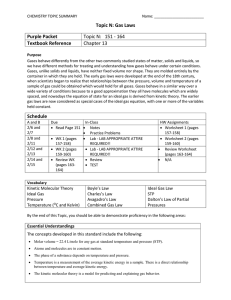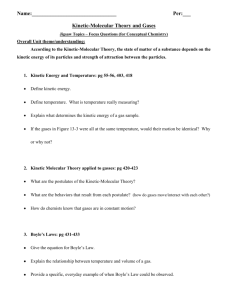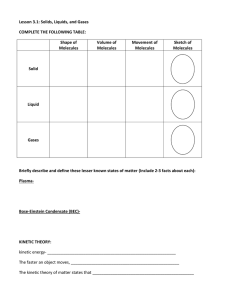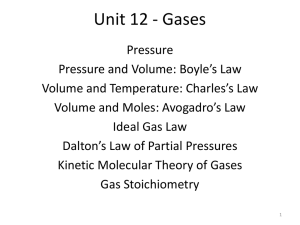Chapter 13: Gas Laws Purpose The Kinetic Molecular Theory can
advertisement
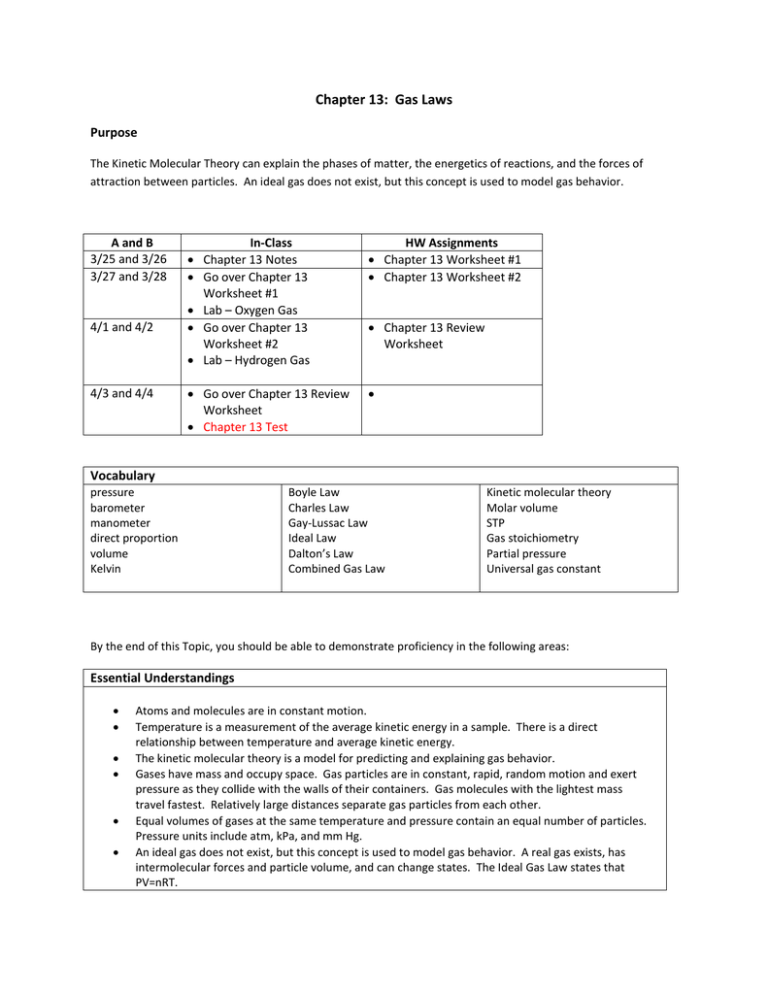
Chapter 13: Gas Laws Purpose The Kinetic Molecular Theory can explain the phases of matter, the energetics of reactions, and the forces of attraction between particles. An ideal gas does not exist, but this concept is used to model gas behavior. A and B 3/25 and 3/26 3/27 and 3/28 4/1 and 4/2 4/3 and 4/4 In-Class Chapter 13 Notes Go over Chapter 13 Worksheet #1 Lab – Oxygen Gas Go over Chapter 13 Worksheet #2 Lab – Hydrogen Gas HW Assignments Chapter 13 Worksheet #1 Chapter 13 Worksheet #2 Go over Chapter 13 Review Worksheet Chapter 13 Test Chapter 13 Review Worksheet Vocabulary pressure barometer manometer direct proportion volume Kelvin Boyle Law Charles Law Gay-Lussac Law Ideal Law Dalton’s Law Combined Gas Law Kinetic molecular theory Molar volume STP Gas stoichiometry Partial pressure Universal gas constant By the end of this Topic, you should be able to demonstrate proficiency in the following areas: Essential Understandings Atoms and molecules are in constant motion. Temperature is a measurement of the average kinetic energy in a sample. There is a direct relationship between temperature and average kinetic energy. The kinetic molecular theory is a model for predicting and explaining gas behavior. Gases have mass and occupy space. Gas particles are in constant, rapid, random motion and exert pressure as they collide with the walls of their containers. Gas molecules with the lightest mass travel fastest. Relatively large distances separate gas particles from each other. Equal volumes of gases at the same temperature and pressure contain an equal number of particles. Pressure units include atm, kPa, and mm Hg. An ideal gas does not exist, but this concept is used to model gas behavior. A real gas exists, has intermolecular forces and particle volume, and can change states. The Ideal Gas Law states that PV=nRT. The pressure and volume of a sample of a gas at constant temperature are inversely proportional to each other (Boyle’s Law: P1V1 = P2V2). At constant pressure, the volume of a fixed amount of gas is directly proportional to its absolute temperature (Charles’ Law: V1/T1 = V2/T2). The Combined Gas Law (P1V1/T1 = P2V2/T2) relates pressure, volume, and temperature of a gas. The sum of the partial pressures of all the components in a gas mixture is equal to the total pressure of a gas mixture (Dalton’s law of partial pressures). Essential Knowledge, and Skills In order to meet this standard, it is expected that students will explain the behavior of gases and the relationship[ between pressure and volume (Boyle’s Law), and volume and temperature (Charles’ Law). solve problems and interpret graphs involving the gas laws. SOL Standards CH.5 The student will investigate and understand that phases of matter are explained by kinetic theory and forces of attraction between particles. Key concepts include a) pressure, temperature, and volume; b) partial pressure and gas laws;

